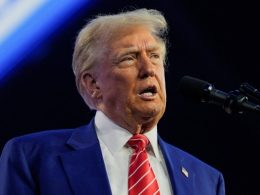Unlock the White House Watch newsletter for free
Your guide to what the 2024 US election means for Washington and the world
Trade economists have poured scorn on the crude methodology used by Donald Trump to calculate the list of “reciprocal” global tariffs imposed by his administration.
Under the US president’s plan set out on Wednesday night, a baseline tariff of 10 per cent will be levied on all imports from all countries excluding Canada and Mexico, while countries with larger trade deficits with the US were hit with much higher numbers.
The formula used to calculate the tariffs, released by the US trade representative, took each country’s trade deficit in goods with the US as a proxy for its alleged unfair practices, then divided it by the amount of goods imported into the US from that country.
The resulting tariff equals half the ratio between the two, resulting in countries such as Vietnam and Cambodia — which send large amounts of manufactured goods to the US but import only small quantities from the US — attracting punitive tariffs of 46 and 49 per cent respectively.
By contrast the UK, with which the US had an annual surplus in goods trade last year, will be hit only by the baseline 10 per cent tariff that applies to all countries barring Canada and Mexico.
Economists argued the USTR methodology was deeply flawed economically and would not succeed in its stated aim of “driving bilateral trade deficits to zero”. They added that, despite the White House’s claims that “tariffs work”, trade balances are driven by a host of economic factors, not simply tariff levels.
Thomas Sampson, associate professor of economics at the London School of Economics, said the formula was “a figleaf for Trump’s misguided obsession with bilateral trade imbalances” and that there was “no economic rationale” for the tariffs.
More broadly, Sampson said tariffs would not remove the underlying macroeconomic driver of the US trade deficit. “As long as the US does not save enough to finance its own investment, it has to borrow from the rest of the world. And that requires it to run a trade deficit. Tariffs don’t change that logic.”
The USTR calculations also apparently ignore previous suggestions by the administration that it would base its reciprocal tariffs on in-depth assessments of bilateral trade relationships, including taxes, regulation and other non-tariff barriers to trade.
Instead, said George Saravelos, head of FX research at Deutsche Bank, the decision to apply larger tariffs on countries with bigger nominal trade deficits was “highly mechanical” and likely to lead to “freewheeling and open-ended” negotiations with the administration as countries moved to try and barter down their tariffs in the coming months.
Economists also attacked Trump’s obsession with reducing bilateral trade deficits to zero as economically illiterate, since there will always be items that it is impossible or economically unviable for countries to grow or make themselves — for example, the US cannot grow its own bananas.
Oleksandr Shepotylo, an econometrician at Aston University, Birmingham, which recently modelled the effects of a global trade war, said the use of economic formulas merely gave the USTR document “a sense of being linked to economic theory”, but it was in fact divorced from the reality of trade economics.
“The formula . . . gives you a level of tariff that would reduce [the] bilateral trade deficit to zero. This is an insane objective. There is no economic reason to have balanced trade with all countries,” he said.
“So in this sense, this policy is very unorthodox and cannot be defended at all.”
The result of the tariffs, added John Springford, trade economist at the Centre for European Reform think-tank, would not be to eliminate trade deficits but to inflict pain on both poorer countries and US consumers.
The formula throws up sharply differing outcomes depending on the sizes of countries’ trade surpluses and deficits with the US. Vietnam is hit with a 46 per cent extra tariff, while Australia, which reports a deficit with the US, is like the UK subject only to the minimum 10 per cent rate.
“This is a recipe for hammering poorer countries with large trade surpluses with the US, not eliminating US trade deficits with them. Their surpluses will shift to other poor countries who make T-shirts and consumer electronics,” Springford said.
“It will also hurt US consumers, because the pass-through of tariffs is higher than USTR claims. And the appreciation of the dollar will tend to offset the effects, by hurting US exports. In short this is both stupid and destructive.”
Innes McFee, of consultancy Oxford Economics, agreed: “Tariffs are not a good way of reducing any country’s trade deficit. The only thing this is going to achieve is a real income shock for US consumers,” he said.
In trying to seek some method in the administration’s approach, Barret Kupelian, chief economist at consultancy PwC, said the “formula” simply reflected Trump’s desire to increase the US manufacturing base and reduce reliance on manufactured imports.
He said: “The question is whether Trump is being transactional or transformational — is he really prepared to go through the transitional pain of this, or this just a transactional lever for extracting concessions from trade partners?”
Source link










